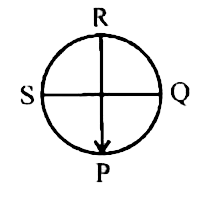A mass m is attached to a thin wire and whirled in a vertical circle. The wire is most likely to break when:
the mass is at the highest point
the wire is horizontal
the mass is at the lowest point
inclined at an angle of 60 from vertical
The correct Answer is:C
(c): Tension of the thread becomes maximum when it crosses the lowest point. Hence wire is most likely to break when it passes through the lowest point . Option (c) is correct .
Topper's Solved these Questions
- BOOK - MODERN PUBLICATIONCHAPTER - MOTION IN A PLANE EXERCISE - COMPETITION FILE OBJECTIVE TYPE QUESTIONS (JEE (Main) & Other Boards for Engineering Entrance)14videos
MOTION IN A PLANE
- BOOK - MODERN PUBLICATIONCHAPTER - MOTION IN A PLANE EXERCISE - COMPETITION FILE OBJECTIVE TYPE QUESTIONS (JEE (Advanced) for IIT Entrance)2videos
MOTION IN A PLANE
- BOOK - MODERN PUBLICATIONCHAPTER - MOTION IN A PLANE EXERCISE - COMPETITION FILE OBJECTIVE TYPE QUESTIONS (A. Multiple Choice Questions)30videos
MOTION IN A PLANE
- BOOK - MODERN PUBLICATIONCHAPTER - MECHANICAL PROPERTIES OF FLUIDSEXERCISE - Chapter Practise Test16videos
MECHANICAL PROPERTIES OF FLUIDS
- BOOK - MODERN PUBLICATIONCHAPTER - MOTION IN A STRAIGHT LINE EXERCISE - CHAPTER PRACTICE TEST16videos
MOTION IN A STRAIGHT LINE
Similar Questions
A heavy mass is attached to a thin wire and is whirled in a vertical circle. The wire is most likely to break
View SolutionConsider a 1m long steel wire with the cross section of 0.05cm2 and Ysteel=2×1011Nm−2.Now a 15 kg mass is attached to the end of the wire and it is whirled in a vertical circle with an angular frequency of 2 rev/s at the bottom of the circle. When the mass is at the lowest point of its path, find the elongation of the wire in mm:
(Take g=10ms−2 & π2=10)View Solution
Knowledge Check
- Question 1 - Select One
A mass m is attached to a thin wire and whirled in a verticle circle. The wire is most likely to break when
Ainclined at an angle of 60∘ from verticalBthe mass is at the highest pointCthe wire is horizontalDthe mass is at the lowest point - Question 2 - Select One
A stone of mass 16 kg is attached to a string 144 m long and is whirled in a horizontal circle .The maximum tension the string can stand is 16 newton .The maximum velocity of revolution that can be given to the stone without breaking it will be
A2ms−1B16ms−1C14ms−1D12ms−1 - Question 3 - Select One
A stone of mass of 16 kg is attached to a string 144 m long and is whirled in a horizontal circle. The maximum tension the string can withstand is 16 Newton . The maximum velocity of revolution that can be given to the stone without breaking it, will be
A20ms−1B16ms−1C14ms−1D12ms−1
A stone of mass 100 g attached to a string of length 50 cm is whirled in a vertical circle by giving it a velocity of 7 m/s at the lowest point. Find the velocity at the highest point .
View SolutionA stone is attached to one end of a string and rotated in a vertical circle . If the string breaks at the position of maximum tension , then it will break at
 View Solution
View SolutionA stone of mass 0.5kg is attached to a string of length 2m and is whirled in a horizontal circle. If the string can withstand a tension of 9N the maximum velcoity with which the stone can be whirled is .
View SolutionA stone of mass 0.5 kg is attached to a string of length 2m and is whirled in a horizontal circle. If the string can withstand a tension of 9N, the maximum velocity with which the stone can be whirled is
View SolutionA stone of mass 1kg is tied with a string and it is whirled in a vertical circle of radius 1 m. If tension at the highest point is 14 N, then velocity at lowest point will be
View Solution

